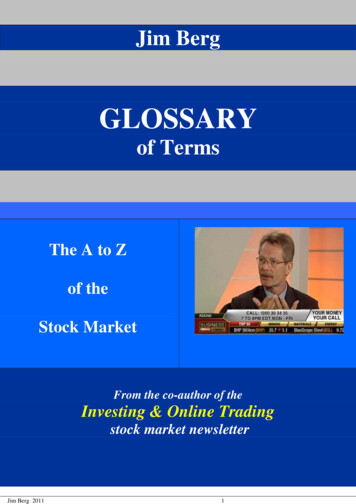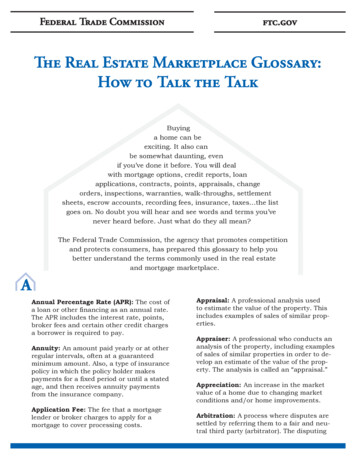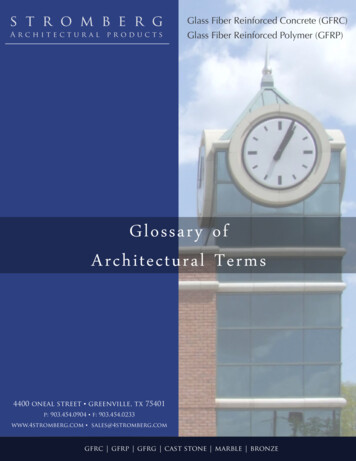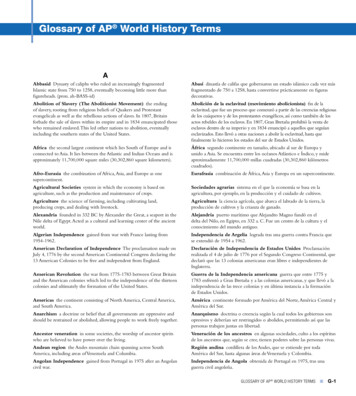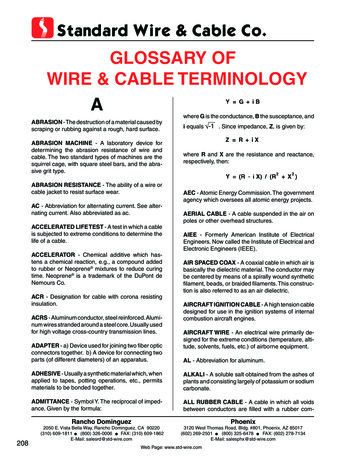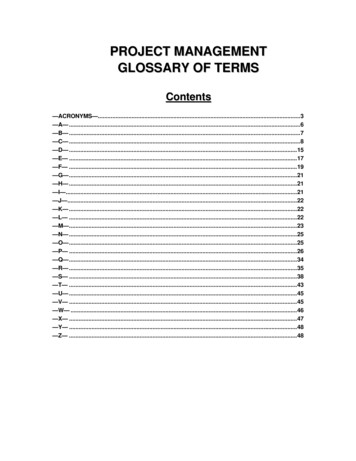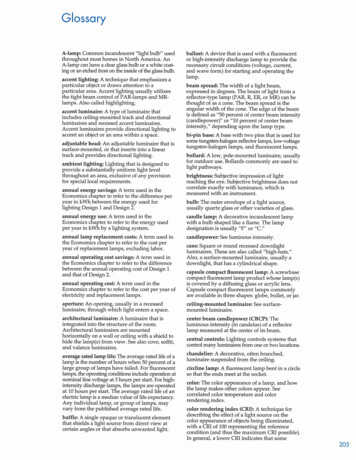
Transcription
GlossaryA-lamp: Common incandescent "light bulb" usedthroughout most homes in North America. AnA-lamp can have a clear glass bulb or a white coating or an etched frost on the inside of the glass bulb.accent lighting: A technique that emphasizes aparticular object or draws attention to aparticular area. Accent lighting usually utilizesthe tight beam control of PAR-lamps and MRlamps. Also called highlighting.accent luminaire:A type of luminaire thatincludes ceiling-mounted track and directionalluminaires and recessed accent luminaires.Accent luminaires provide directional lighting toaccent an object or an area within a space.adjustable head: An adjustable luminaire that issurface-mounted, or that inserts into a lineartrack and provides directional lighting.ambient lighting: Lighting that is designed toprovide a substantially uniform light levelthroughout an area, exclusive of any provisionfor special local requirements.annual energy savings: A term used in theEconomics chapter to refer to the difference peryear in kwh between the energy used forlighting Design 1 and Design 2.ballast: A device that is used with a fluorescentor high-intensity discharge lamp to provide thenecessary circuit conditions (voltage, current,and wave form) for starting and operating thelamp.beam spread: The width of a light beam,expressed in degrees. The beam of light from areflector-type lamp (PAR, R, ER, or MR) can bethought of as a cone. The beam spread is theangular width of the cone. The edge of the beamis defined as "50 percent of center beam intensity(candlepower)"or "10 percent of center beamintensity," depending upon the lamp type.bi-pin base: A base with two pins that is used forsome tungsten-halogen reflector lamps, low-voltagetungsten-halogenlamps, and fluorescent lamps.bollard: A low, pole-mounted luminaire, usuallyfor outdoor use. Bollards commonly are used tolight pathways.brightness: Subjective impression of lightreaching the eye. Subjective brightness does notcorrelate exactly with luminance, which ismeasured with an instrument.bulb: The outer envelope of a light source,usually quartz glass or other varieties of glass.annual energy use: A term used in theEconomics chapter to refer to the energy usedper year in kwh by a lighting system.candle lamp: A decorative incandescent lampwith a bulb shaped like a flame. The lampdesignation is usually 'IF" or "C."annual lamp replacement costs: A term used inthe Economics chapter to refer to the cost peryear of replacement lamps, excluding labor.candlepower: See luminous intensity.annual operating cost savings: A term used inthe Economics chapter to refer to the differencebetween the annual operating cost of Design 1and that of Design 2.cans: Square or round recessed downlightluminaires. These are also called "high-hats."Also, a surface-mounted luminaire, usually adownlight, that has a cylindrical shape.annual operating cost: A term used in theEconomics chapter to refer to the cost per year ofelectricity and replacement lamps.capsule compact fluorescent lamp: A screwbasecompact fluorescent lamp product whose lamp(s)is covered by a diffusing glass or acrylic lens.Capsule compact fluorescent lamps commonlyare available in three shapes: globe, bullet, or jar.aperture:An opening, usually in a recessedluminaire, through which light enters a space.ceiling-mounted luminaire: See surfacemounted luminaire.architectural luminaire:A luminaire that isintegrated into the structure of the room.Architectural luminaires are mountedhorizontally on a wall or ceiling with a shield tohide the lamp(s) from view. See also cove, soffit,and valance luminaires.center beam candlepower (CBCP):Theluminous intensity (in candelas) of a reflectorlamp measured at the center of its beam.average rated lamp life: The average rated life of alamp is the number of hours when 50 percent of alarge group of lamps have failed. For fluorescentlamps, the operating conditions include operation atnominal line voltage at 3 hours per start. For highintensity discharge lamps, the lamps are operatedat 10 hours per start. The average rated life of anelectric lamp is a median value of life expectancy.Any individual lamp, or group of lamps, mayvary from the published average rated life.chandelier:A decorative, often branched,luminaire suspended from the ceiling.baffle: A single opaque or translucent elementthat shields a light source from direct view atcertain angles or that absorbs unwanted light.central controls: Lighting controls systems thatcontrol many luminaires from one or two locations.circline lamp: A fluorescent lamp bent in a circleso that the ends meet at the socket.color: The color appearance of a lamp, and howthe lamp makes other colors appear. Seecorrelated color temperature and colorrendering index.color rendering index (CRI):A technique fordescribing the effect of a light source on thecolor appearance of objects being illuminated,with a CRI of 100 representing the referencecondition (and thus the maximum CRI possible).In general, a lower CRI indicates that some
colors may appear unnatural when illuminatedby the lamp. CRIs of two or more lamps shouldonly be compared if the lamps have the samecorrelated color temperature. See also correlatedcolor temperature.color temperature: See correlated colortemperature.commodity-grade luminaire: A commonlyavailable luminaire that is constructed of lessexpensive materials, with lower-qualityconstruction standards. It is usually lower inprice than a specification-grade luminaire.Commodity-grade luminaires commonly areused in homes and are available at discountstores and some electrical suppliers.common incandescent lamp: See A-lamp.compact fluorescent lamp: A small fluorescentlamp, usually with one or more bends in the tube.contrast: The relative brightness (luminance)ofan object against its immediate background.control: A mechanism to turn lamps on and off,or dim lamps. Controls include switches,dimmers, timing devices, motion detectors,photosensors, and central control systems.cornice luminaire: See soffit luminaire.correlated color temperature (CCT):Describesthe color appearance of the light that isproduced, in terms of its warmth or coolness.The CCT relates the color appearance of thelamp to the color appearance of a referencesource when the reference source is heated to aparticular temperature, measured on the Kelvin(K) temperature scale. A low color temperature(3000 K and lower) describes a warm source,such as a typical incandescent lamp and a warmfluorescent lamp. A high color temperature(4000 K and higher) describes a cool source, suchas a cool white fluorescent lamp.cove luminaire: An architectural luminaire thatdirects light from sources that are mounted in acove to the ceiling or upper wall. A cove is aledge or shelf on the wall, or a recess in the wall.current: A flow of electric charge, measured inamperes or amps.daylight: Light produced by solar radiation.Daylight includes direct sunlight, sunlightscattered by the atmosphere, and sunlightreflected from clouds or other surfaces.Design 1:A term used in the Economics chapter torefer to an existing lighting system, a commonpractice lighting system, or any other lightingdesign that serves as a point of reference forcomparison to another lighting design, Design 2.Design 2: A term used in the Economics chapterto refer to a new lighting system that is beingcompared to Design 1.diffuse lighting: Lighting provided on the workplane or on an object that does not come from anyparticular direction. Diffuse lighting producesless-distinct shadows than directional lighting.diffuser: A device to redirect or scatter the lightfrom a source, primarily by the process ofdiffuse transmission.dimmer: A device used to control the intensityof light emitted by a luminaire by controlling thevoltage or current available to it.dimming power reduction factor: See powerreduction factor.direct glare: Glare resulting from very brightsources of light in the field of view. It usually isassociated with bright light from luminaires andwindows. A direct glare source may also affectperformance by reducing the apparent contrastof objects in the field of view, especially thosenear the source of light.directional lighting: The lighting produced byluminaires that distribute all, or nearly all, of thelight in one direction.directional luminaire: A luminaire thatprovides directional lighting, includingdownlights, accent luminaires, and the like.distribution: See light disttibution.downlight: A directional luminaire that directslight downward.efficacy (of a light source):The total light outputof a light source divided by the total powerinput. Efficacy is expressed in lumens per watt.efficiency (of a luminaire):The ratio of luminousflux (lumens) emitted by a luminaire to thatemitted by the lamp or lamps used therein.Luminous efficiency is a dimensionless measure,expressing the percentage of initial lamp lumensthat ultimately are emitted by the luminaire.electromagnetic interference (EMI):Theimpairment of a wanted electromagnetic signalby an electromagnetic disturbance.electronic ballast: A ballast that uses electroniccircuitry to provide the voltage and current thatare needed to start the lamp(s) and to maintainits operation. Electronic ballasts weigh less thanmagnetic ballasts and operate more quietly.Electronic ballasts operate lamps at a higherfrequency than magnetic ballasts (20,000 to 60,000hertz compared to 60 hertz), which eliminatesflicker and increases efficacy. See also ballast.ellipsoidal reflector lamp (ER-lamp):Anincandescent lamp with an internal reflector thathas a focal point a few inches in front of thelamp face. ER-lamps are used in grooved-bafflerecessed downlights or track heads to reduce theamount of light absorbed by the baffle trim.energy: The product of power (watts) and time(hours). Energy used for lighting can be savedeither by reducing the amount of power requiredor by reducing the amount of time lighting is used.ER-lamp: An ellipsoidal reflector lamp.exterior lighting: Lighting for the outside of abuilding, including decorative and functionallighting.
"eyeball"luminaire: A recessed luminaire witha partially recessed sphere that can be rotated toprovide adjustable, directional lighting.facade lighting: Floodlighting the exterior of astructure for security or for illuminatingarchitecturalfeatures.filament: A fine wire heated electrically toincandescence in an electric lamp.fitting: See luminaire.fixture: See luminaire.flood lamp: A lamp that produces a relativelywide beam of light.fluorescence: The ability of some materials, suchas phosphors, to convert ultraviolet energy intovisible light.fluorescent lamp: A lamp containing mercuryunder low pressure, relative to high-intensitydischarge lamps. The mercury is ionized by anelectric arc, producing ultraviolet energy which,in turn, excites phosphors coating the inside ofthe lamp to fluoresce.footcandle: Imperial unit of illuminance equal toone lumen per square foot. One footcandleequals 10.76 lux.footlambert: Imperial unit of luminance equal to1/IT candelas per square foot. One footlambertequals 3.426 candelas/m2(nits).four-way switch: One of three switches thatcontrols the same luminaire or group of luminaires.The luminaire(s)may be turned on or off fromany of the three switches. It is called a four-wayswitch because it contains four contact points:the luminaire and the three switches.G-lamp: A globe-shaped incandescent lamp,usually having a spherical bulb.general lighting: See ambient lighting.glare: The loss of visibility and/or the sensationof discomfort associated with bright light withinthe field of view. See also direct glare andreflected glare.globe: A spherical transparent or diffusingenclosure that is intended to protect a lamp, todiffuse its light, or to change the color of the light.globe lamp: An incandescent lamp with a globeshaped bulb or a compact fluorescent lamp witha globe-shaped diffusing cover. See also capsulecompact fluorescent lamp.globe luminaire: A luminaire with a sphericaldiffuser, typically used for ambient lighting.grazing light: Directional, usually downward,light that emphasizes the texture of surfaces bycreating contrast between highlights on raisedportions and shadows beyond them. Heavilytextured surfaces, such as stucco, arecomplemented by grazing light.halogen incandescent lamp: An incandescentlamp whose filament is encapsulated; thecapsule contains a halogen gas that reacts withtungsten evaporated from the filament toredeposit it on the filament. Halogenincandescent lamps have higher efficacies thancommon incandescent lamps. They aresometimes referred to as quartz lamps becausethe capsule is made from quartz glass.halophosphates: The class of phosphors thatcommonly are used in fluorescent lamps.Halophosphates are limited in their ability toprovide a high color rendering index withoutsacrificing light output. See also rare-earthphosphors.HID lamps: High-intensity discharge lamps."high-hat"luminaire:A square or roundrecessed downlight luminaire. Also called a "can.'high-intensity discharge (HID) lamps: A groupof electric discharge lamps operating at relativelyhigh pressures (compared to fluorescent lamps).This group includes the lamp types known asmercury vapor, metal halide, and high-pressuresodium.highlighting:See accent lighting.high-pressure sodium lamp: HID light source inwhich radiation from sodium vapor under highpressure produces visible light. High-pressuresodium lamps are orangish in color appearance,take a few minutes to achieve full light output onlamp startup, and require several minutes to restartif power to the lamp is interrupted, even briefly."Hollywood" lights: A luminaire that uses a stripof multiple globe lamps mounted on one or moresides of a mirror. They are common in bathrooms."hot spot": An area of higher illumination thanthat on the immediate surrounding area, oftenresulting from a lamp being placed close to asurface. Hot spots also can occur due to
Design 1: A term used in the Economics chapter to refer to an existing lighting system, a common- practice lighting system, or any other lighting design that serves as a point of reference for comparison to another lighting design, Design 2. Design 2: A term used in the Economics chapter to refer to a new lighting system that is being





